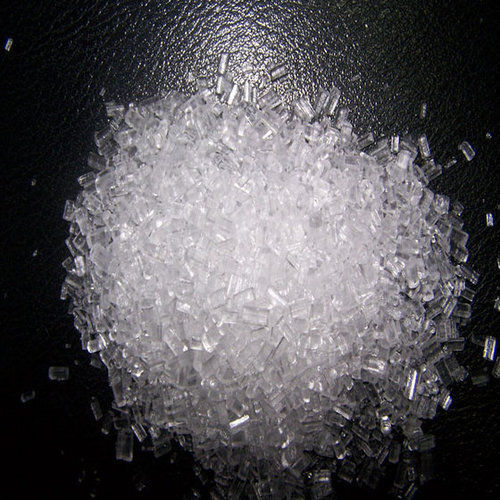Sodium Thiosulphate
85 INR/Kilograms
Product Details:
X
Sodium Thiosulphate Price And Quantity
- 85 INR/Kilograms
- 20000 Kilograms
Sodium Thiosulphate Trade Information
- 10000 Kilograms Per Day
- 1 Week
Product Description
Sodium thiosulfate (Na2S2O3), also known as sodium thiosulphate, is a chemical compound composed of sodium, sulfur, and oxygen.
Sodium Thiosulphate Properties:
1. Physical State: Sodium thiosulfate typically exists as a colorless, crystalline solid at room temperature. It can also be found in a pentahydrate form, Na2S2O3 5H2O, which appears as white crystals.
2. Solubility: It is highly soluble in water, with approximately 70 grams dissolving in 100 milliliters of water at room temperature. This high solubility makes it convenient for various applications, such as in photography and water treatment.
3. Odor: Sodium thiosulfate is odorless.
4. pH: Aqueous solutions of sodium thiosulfate are neutral or slightly alkaline, with a pH typically around 7 to 9.
5. Hygroscopicity: The anhydrous form of sodium thiosulfate is not hygroscopic, but the pentahydrate form absorbs moisture from the air.
6. Melting and Boiling Points: Sodium thiosulfate pentahydrate melts around 48 degree centigrade and decomposes upon further heating. It doesn't have a distinct boiling point as it decomposes before reaching its boiling point.
7. Stability: Sodium thiosulfate is stable under normal conditions but can decompose upon heating, releasing toxic sulfur dioxide gas. It can also slowly decompose in solution, especially in acidic conditions.
8. Redox Properties: Sodium thiosulfate can act as a reducing agent or an oxidizing agent depending on the reaction conditions. For example, it can reduce iodine to iodide ions or be oxidized by strong oxidizing agents like chlorine.
9. Complex Formation: Sodium thiosulfate can form complexes with various metal ions, which can influence its properties and applications in analytical chemistry and other fields.
Sodium Thiosulphate Applications:
1. Photography: Sodium thiosulfate is widely used in photographic processing as a fixing agent. It helps remove unexposed silver halide from photographic film and paper, making the image permanent.
2. Water Treatment: It is employed in water treatment processes to neutralize chlorine and chloramines in municipal water supplies and swimming pools. Sodium thiosulfate helps eliminate residual chlorine, which can be harmful if present in excess.
3. Medical Uses: Sodium thiosulfate serves as an antidote for cyanide poisoning. It reacts with cyanide to form thiocyanate, a less toxic compound, thereby helping to detoxify the body.
4. Analytical Chemistry: In analytical chemistry, sodium thiosulfate is utilized as a titrant in the iodine clock reaction and in other iodometric titrations. It reacts with iodine produced in reactions involving iodine, iodate, and iodide ions.
5. Gold Extraction: Sodium thiosulfate is an alternative to cyanide in gold extraction processes. It is used in gold mining operations to dissolve gold from ores without the environmental and health risks associated with cyanide.
6. Chemical Industry: It serves as a reducing agent, sulfur source, and sulfur donor in various chemical reactions. Sodium thiosulfate is employed in the synthesis of organic compounds and in industrial processes requiring the removal of excess chlorine or as a reducing agent in certain chemical transformations.
7. Hair Care Products: In hair care products, particularly hair bleach, sodium thiosulfate is added to neutralize excess bleach and prevent damage to the hair.
8. Preservative: In some cases, sodium thiosulfate is used as a preservative to extend the shelf life of certain foods and beverages.
9. Pharmaceuticals: It is utilized in some pharmaceutical formulations and processes as a stabilizer or reducing agent.
Sodium Thiosulphate FAQ:
Q: What is sodium thiosulfate?
A: Sodium thiosulfate, also known as sodium thiosulphate, is a chemical compound with the formula Na2S2O3. It is composed of sodium (Na), sulfur (S), and oxygen (O) atoms.
Q: What does sodium thiosulfate look like?
A: Sodium thiosulfate typically exists as a colorless, crystalline solid at room temperature. It can also be found in a pentahydrate form, which appears as white crystals.
Q: What is sodium thiosulfate used for?
A: Sodium thiosulfate has various applications, including:
- Photographic processing as a fixing agent.
- Water treatment to neutralize chlorine and chloramines.
- Medical treatment for cyanide poisoning.
- Analytical chemistry as a titrant and in iodometric titrations.
- Gold extraction in mining.
- Chemical synthesis and industrial processes.
Q: Is sodium thiosulfate safe?
A: Sodium thiosulfate is generally considered safe when handled properly. However, it should be used with caution as it can cause irritation to the skin, eyes, and respiratory system. Ingestion or inhalation of large amounts can be harmful.
Q: How is sodium thiosulfate disposed of?
A: Sodium thiosulfate should be disposed of properly according to local regulations. It is typically neutralized and diluted before disposal. It should not be poured down the drain without proper treatment.
Q: Can sodium thiosulfate be stored for long periods?
A: Sodium thiosulfate should be stored in a cool, dry place away from incompatible materials. Properly stored, it can have a relatively long shelf life.
Q: Can sodium thiosulfate be used in food?
A: Sodium thiosulfate is not typically used directly in food products. However, it may be used as a preservative in some cases or as an ingredient in certain food processing applications.
Q: How does sodium thiosulfate work in photography?
A: In photography, sodium thiosulfate acts as a fixing agent. It removes unexposed silver halide from photographic film and paper, making the image permanent and preventing further darkening.
Q: Is sodium thiosulfate environmentally friendly?
A: Sodium thiosulfate is considered to be relatively environmentally friendly compared to some alternative chemicals, such as cyanide, which is often used in gold extraction. However, like any chemical, its environmental impact depends on how it is used and disposed of.
Tell us about your requirement

Price:
Quantity
Select Unit
- 50
- 100
- 200
- 250
- 500
- 1000+
Additional detail
Mobile number
Email






 Send Inquiry
Send Inquiry Send SMS
Send SMS Call Me Free
Call Me Free
